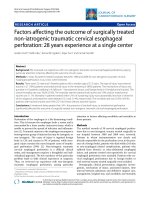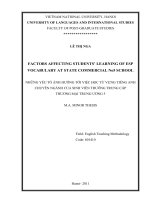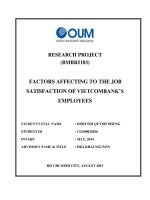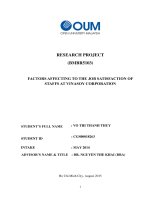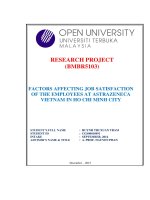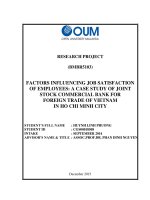Factors affecting job satisfaction of software engineers at haveynash vietnam master project in business administration
Bạn đang xem bản rút gọn của tài liệu. Xem và tải ngay bản đầy đủ của tài liệu tại đây (2.73 MB, 98 trang )
TRƯỜNG ĐẠI HỌC MỞ TP. HCM
HO CHI MINH CITY OPEN UNIVERSITY
UNIVERSITE LIBRE DE BRUXELLES
SOLVAY BRUSSELS SCHOOL
MBAVB3
TRẦN QUỐC TRÍ
FACTORS AFFECTING JOB SATISFACTION OF
SOFTWARE ENGINEERS AT HARVEYNASH VIETNAM
MASTER PROJECT
MASTER IN BUSINESS ADMINISTRATION
(PART-TIME)
Tutor’s Name: Dr. VŨ VIỆT HẰNG
Ho Chi Minh City
(2010)
i
UNDERTAKINGS
I would like to undertake that, to carry out this thesis “Factors affecting job
satisfaction of software engineers at Harveynash Vietnam”, I have myself
studied and researched the project’s issue, applied the academic knowledge
obtained from the MBAVB program, and discussed with my supervisor.
I undertake that this is my own research project, all information, data and survey
results are true and never announced in any other research projects.
Ho Chi Minh City, 22 February 2011
TRAN QUOC TRI
ii
ACKNOWLEDGEMENT
I would like to express the deepest appreciation to Dr. Vu Viet Hang for her time
and her valuable advice to help me to finish this project.
I would like to thank all professors from both Open University and
SolvayBusinessSchool who had given me the academic knowledge and shared with
me their practical experience.
I also would like to thank all employees at Harveynash Vietnam who help me to
join my survey for this project.
iii
TUTOR’S COMMENTS
It’s a pleasure to supervise Tran Quoc Tri for this final task forward completing his
master in business management. In the course of the project implementation, I’ve
formed a good impression of the preparatory work completed by Tri as well as his
responsibility and trustworthiness. I’d like to highlight key accomplishment of this
research report as follows
1. The author succeeded in maintaining cohesion between different parts of the
research, from the literature review, the status quo to solutions
recommendation.
2. The research was developed on the basis of modern and solid theories.
3. The author achieved the primary objective of doing a serious work of
collecting data and thoroughly analyzing them to provide meaningful
information and recommendations.
4. The results of this research can be applied in real life situations and address
them in a practical way.
I would encourage the management of the author’s company to adopt the
recommendations of the research to help improve the employee satisfaction at
Harveynash Vietnam.
Ho Chi Minh City, 22 February 2011
Dr. VU VIET HANG
iv
TABLE OF CONTENT
Chapter 1
Introduction ......................................................................................... 1
1.1
Overview ......................................................................................................1
1.2
Research problem and research objectives...................................................1
1.2.1
Research problem .................................................................................1
1.2.2
Research objectives ...............................................................................2
1.3
Research questions and hypotheses..............................................................2
1.3.1
Research questions................................................................................2
1.3.2
Research hypotheses .............................................................................3
1.4
Research methodology .................................................................................4
1.5
Delimitations ................................................................................................4
1.6
Structure of the study ...................................................................................4
Chapter 2
Literature review ................................................................................ 6
2.1
Concepts and definitions of job satisfaction ................................................6
2.2
Theories relating to job satisfaction .............................................................7
2.2.1
Maslow’s Hierarchy of Need (1943) ....................................................7
2.2.2
Herzberg’s Two Factor Theory (1959) .................................................8
2.2.3
Vroom’s Expectancy Theory (1964) ...................................................10
2.2.4
Hackman and Oldham's Job Characteristics Model (1974) ..............11
2.3
The measurement of job satisfaction ..........................................................12
2.4
Researches related to job satisfaction.........................................................17
2.4.1
Organizational factors and job satisfaction .......................................17
2.4.2
Demographic factors and job satisfaction ..........................................20
v
2.5
Developing the research model ..................................................................21
Chapter 3
Research Methodology .....................................................................23
3.1
Research Process ........................................................................................23
3.2
Population and sample................................................................................24
3.3
Data collection ............................................................................................25
3.4
Questionnaire design ..................................................................................26
3.5
Data analysis method..................................................................................28
Chapter 4
Data analysis and findings................................................................31
4.1
Profile of samples .......................................................................................31
4.2
Means of job satisfaction............................................................................31
4.3
Reliability analysis .....................................................................................34
4.4
Factor analysis ............................................................................................36
4.5
Comparison of job satisfaction by demographic factors ............................38
4.5.1
Comparison of job satisfaction by gender and marital status ............38
4.5.2
Comparison of job satisfaction by years of experience ......................39
4.5.3
Comparison of job satisfaction by length of service and position ......40
4.6
Regression analysis ....................................................................................41
4.6.1
Assumptions checking .........................................................................41
4.6.2
Model evaluation ................................................................................43
4.6.3
Evaluation of independent variables ..................................................44
4.7
Summary of research findings....................................................................45
4.8
Revised research model ..............................................................................48
Chapter 5
Conclusion and implication..............................................................49
vi
5.1
Conclusion ..................................................................................................49
5.1.1
Means of job satisfaction ....................................................................49
5.1.2
Personal antecedents of job satisfaction ............................................49
5.1.3
Organizational antecedents of job satisfaction ..................................51
5.2
Recommendations ......................................................................................51
5.3
Contributions ..............................................................................................52
5.4
Limitations and recommendations for future researches ...........................53
REFERENCES
............................................................................................................. 54
APPENDIX 1
THE QUESTIONNAIRE .................................................................... 57
APPENDIX 2
PROFILE OF SAMPLES .................................................................... 64
APPENDIX 3
RELIABILITY ANALYSIS ................................................................ 65
APPENDIX 4
SUITABILITY ASSESSMENT FOR FACTOR ANALYSIS ............ 69
APPENDIX 5
FACTOR EXTRACTION ................................................................... 71
APPENDIX 6
FACTOR ROTATION ........................................................................ 77
APPENDIX 7
FACTORS
COMPARISON OF JOB SATISFACTION BY DEMOGRAPHIC
............................................................................................................. 79
APPENDIX 8
ASSUMPTIONS CHECKING FOR MULTIPLE REGRESSION ..... 86
APPENDIX 9
REGRESSION ANALYSIS ................................................................ 87
vii
LIST OF ABBREVIATIONS
HVN
Harveynash Vietnam
IT
Information Technology
SPSS
Statistical Package for Social Sciences
JDI
Job Descriptive Index
JSS
Job Satisfaction Survey
MSQ
Minnesota Satisfaction Questionnaire
JIG
Job in General
SD
Standard Deviation
EFA
Exploratory Factor Analysis
KMO
Kaiser-Meyer-Olkin
VIF
Variance Inflation Factor
QC
Quality Assurance
CPI
Consumer Price Index
viii
LIST OF FIGURES
Figure 1: Outline of the thesis .....................................................................................5
Figure 2: Maslow’s Hierarchy of Needs .....................................................................8
Figure 3: Herzberg’s two factor theory .......................................................................9
Figure 4: Vroom expectancy theory..........................................................................10
Figure 5: Job Characteristics Model .........................................................................12
Figure 6: Six facial expressions from the Faces scale ..............................................15
Figure 7: Proposed research model ...........................................................................22
Figure 8: The research process ..................................................................................23
Figure 9: Revised research model .............................................................................48
ix
LIST OF TABLES
Table 1: Internal consistency reliability for the Job Satisfaction Survey .................14
Table 2: Items from the Michigan Organizational Assessment Questionnaire
Satisfaction subscale .................................................................................................16
Table 3: Measurement scales of satisfaction level ....................................................27
Table 4: Divisions of facets satisfaction into 36 items .............................................27
Table 5: Mappings between satisfaction scores and satisfaction levels ...................32
Table 6: Means of the items in construct “pay” ........................................................32
Table 7: Summary of satisfaction scores ..................................................................33
Table 8: The results of the One-Sample T-test .........................................................33
Table 9: Results of reliability analysis of items ........................................................35
Table 10: Factor analysis results ...............................................................................38
Table 11: Multicollinearity check results for independent variables ........................42
Table 12: Regression model summary and statistical significant of the results .......43
Table 13: Multiple regression results ........................................................................44
Table 14: Summary of hypothesis testing results .....................................................47
1
CHAPTER 1
INTRODUCTION
1.1 Overview
Job satisfaction is one of the most frequently studied variables in organizational
behavior research. Job satisfaction surveys are commonly used by organizations to
help manage and retain valuable employees. Job satisfaction is found to be a
predictor of turnover intentions. According to Meyer (1999, cited in Luddy, 2005),
employees experience a lack of job satisfaction resulting in a low level of employee
commitment that, in turn, impacts on performance and the achievement of
organizational goals. The symptoms of these problems result in low productivity,
high absenteeism, and high employee turnover. Researches on turnover intention of
IT employees also suggested that “IT employees seem to be quicker to change jobs
than other employees when they are dissatisfied with their employer” (Hacker,
2003).
The purpose of the study is to understand the satisfaction level of software
engineers at HVN and the factors affecting job satisfaction.
1.2 Research problem and research objectives
1.2.1
Research problem
Harveynash Vietnam (HVN) is one of the biggest software outsourcing companies
in Vietnam. As HVN is rapidly expanding, the number of employee at software
division is increasing year over year. By the end of December 2009, the total
software engineers at HVN is 323, 20% increase compared to the year 2008.
However, beside the expansion, the turnover is also increasing. In the year 2009,
there were 47 software engineers left HVN. As job satisfaction is strongly
correlated with turnover intentions, studying on job satisfaction is considered as the
first step to help retain software engineers at HVN. This gives motivation for this
2
research in measuring the level of job satisfaction of software engineers at HVN as
well as the impact of demographic and organizational factors on job satisfaction.
1.2.2
Research objectives
In attempting to answer the research problems, this research is directed to the
following objectives:
1. To measure the overall satisfaction of software engineers at HVN as well as
the level of satisfaction with facets of their job.
2. To determine the demographic factors affecting overall job satisfaction.
3. To measure the level of impact of organizational factors on overall job
satisfaction of software engineers at HVN.
1.3 Research questions and hypotheses
Demographic and organizational factors that found to be associated with job
satisfaction will be elaborated in Error! Reference source not found.. The
research questions and hypotheses are developed based on these factors.
1.3.1
Research questions
This research investigates the following research questions:
Q1. What is the overall job satisfaction of software engineers at HVN?
Q2. What degree of satisfaction do software engineers express with each of the
facets of their job such as pay, promotion, supervision, fringe benefits,
contingent rewards, working environment, coworkers, nature of work and
communication?
Q3. Are there significant differences in job satisfaction of software engineers at
HVN by their personal factors such as gender, marital status, years of
experience, present position, and number of years working at HVN?
Q4. What is the level of impact of organizational factors such as pay, promotion,
supervision, fringe benefits, contingent rewards, working environment,
coworkers, nature of work and communication on the overall job satisfaction
of the software engineers at HVN?
3
1.3.2
Research hypotheses
The following hypotheses were proposed for the research.
Hypothesis H1: There are significant differences in job satisfaction of software
engineers at HVN by demographic factors such as gender, marital status, years of
experience, present position, and length of service.
H1a:There is significant difference in job satisfaction between male and female
software engineers.
H1b: There is significant difference in job satisfaction between single and married
software engineers.
H1c: There is significant difference in job satisfaction between software engineers
having different length of service for the company.
H1d: There is significant difference in job satisfaction between software engineers
having different years of experience.
H1e: There is significant difference in job satisfaction between software engineers
working in different positions.
Hypothesis H2: The organizational factors such as pay, promotion, supervision,
fringe benefits, contingent rewards, working environment, coworkers, nature of
work and communication are positively related to the overall job satisfaction.
H2a: Pay is positively related to the overall job satisfaction.
H2b: Promotion is positively related to the overall job satisfaction.
H2c: Supervision is positively related to the overall job satisfaction.
H2d: Fringe benefits are positively related to the overall job satisfaction.
H2e: Contingent rewards are positively related to the overall job satisfaction.
H2f: Operating procedures are positively related to the overall job satisfaction.
H2g: Coworkers are positively related to the overall job satisfaction.
4
H2h: Nature of work is positively related to the overall job satisfaction.
H2i: Communication is positively related to the overall job satisfaction.
1.4 Research methodology
In this research, quantitative method is applied to examine the research questions
and hypotheses. A structured survey questionnaire was administered to collect
primary data from software engineers working at HVN.Data were collected using
an online survey designed in Google Docs. The Statistical Package for Social
Sciences (SPSS) v.16 was utilized to analyze the data.
1.5 Delimitations
This section identifies the limits beyond which this research does not have
significance.
In this research, demographic factors were limited to just 5 factors, despite that
there could be other factors such as age, educational level… need to be inspected.
Similarly, organizational factors were limited to the 9 facets of job.
Moreover, the sample size in this research is quite small due to time limitation. A
large sample will make the findings more trustworthy.
Finally, the study was conducted at HVN so the results and implications of the
study are applicable for only HVN. However, the research model and research
methods used in this study are not limited to the context of HVN.
1.6 Structure of the study
This thesis consists of five chapters. Chapter 1 provides an overview of the
research context. The research problem and questions are identified, and the
research model and hypotheses are constructed. Brief introduction about the
research methodology used for this study as well as delimitations of this study are
also discussed. Chapter 2 presents the literature reviews carriedout for this
research. Concepts and definitions of job satisfaction, together with theories relating
5
to job satisfaction, the measurement of job satisfaction and researches related to job
satisfaction are discussed.Chapter 3 deals with the methodology of research
employed in this thesis. Chapter 4describes the analysis of the data and testing of
the hypotheses of the proposed model and the last chapter, Chapter 5, presents
conclusions and implications of the research.Figure 1provides a conceptual outline
of this thesis.
Figure 1: Outline of the thesis
Chapter 1
Introduction
Chapter 2
Chapter 3
Literature
review
Research
methodology
Chapter 4
Data analysis
and findings
Source: Developed for this research
Chapter 5
Conclusion
and
implication
6
CHAPTER 2
LITERATURE REVIEW
2.1 Concepts and definitions of job satisfaction
Job satisfaction has been defined in a number of ways. According to Vroom (1967,
cited in Kaya, 1995), job satisfaction is the reaction of the workers against the role
they play in their work.Rue and Byars (1992, cited in Luddy, 2005) referred to job
satisfaction as an individual’s mental state about the job. This definition was
expanded by Greenberg and Baron (1995) who defined job satisfaction as an
individual’s cognitive, affective and evaluativereactions toward their job.
Schermerhorn (1993) defined job satisfaction as an affective or emotional response
towards various aspects of an employee’s work. According to the author, causes of
job satisfaction include status, supervision, co-worker relationships, job content,
remuneration and extrinsic rewards, promotion and physical conditions of the work
environment, as well as organizational structure.
According to Kreitner and Kinicki (2007), job satisfaction reflects the extent to
which individuals like their jobs. It is employee’s feeling toward his/her job.
Spector (1997) defined job satisfaction as the extent to which people like or dislike
their jobs. This definition suggests job satisfaction as a general or global affective
reaction that individuals hold about their job. This view is supported by Ellickson
and Logsdon (2002) who defined job satisfaction as the extent to which people like
their work.
According to Cherrington (1994, cited in Luddy, 2005), the concept of job
satisfaction could be understood as either facet satisfaction or overall satisfaction.
Facet satisfaction refers to the tendency for an employee to be more or less satisfied
with various facets of the job such as pay, the work itself, compensation, career
7
opportunities… Overall satisfaction refers to a person's attitude toward his or her
job that cuts across the various facets
2.2 Theories relating to job satisfaction
Several theories have been proposed to explain the concept of job satisfaction,
including Maslow’s hierarchy of need, Herzberg’s two factor theory, Vroom’s
expectancy theory and Job Characteristics Model by Hackman and Oldham.
2.2.1
Maslow’s Hierarchy of Need (1943)
One of the most widely recognized theory is Adam Moslow’s need-based theory of
motivation. Maslow's hierarchy explains human behavior in terms of basic
requirements for survival and growth. These requirements, or needs, are arranged
according to their importance for survival and their power to motivate the
individual. According to the author, people’s need could be classified into five
levels of needs: physiological needs, safety needs, social needs, esteem needs
andself-actualization needs. The details of these 5 levels were shown in Figure 2.
Physiological needs are the first and lowest level of needs. These are the basic
requirements for human physical survival. They include such essentials as food,
water, shelter, oxygen, and sleep. Safety needs include the needs for safety,
protection against threads, fair treatment, job security, etc.Social needs refer to the
needs of love and being love, accepted, part of the group or organization, etc.
whereas esteem needs refer to the needs for being respected, being recognized and
being appreciated. Finally, self-actualization needs, the highest in Maslow’s
pyramid, refer to the desire to become more and more what one is, to become
everything that one is capable of becoming.
Maslow stated that lower needs must be reasonably well satisfied in order for the
person to focus on higher needs, but he noted that complete satisfaction of a given
need may not be possible or necessary. Moreover, once a need is fulfilled, it
disappears as the individual moves on to the next level.
8
F
Figure
2:M
Maslow’s Hierarchy
H
of Needs
Soource: wikkipedia.orgg
2.2.2
H
Herzberg
’s Two Factor
F
Theory
T
(11959)
A
According
t Herzberg, peoplee are influ
to
uenced by two factoors. Satisfaaction andd
pssychologiccal growth is a resullt of motiv
vation facttors whilstt dissatisfaaction is a
reesult of hyygiene facctors. Herzzberg also
o pointed out that tthe opposite of jobb
saatisfaction is not job dissatisfacction, but rather no job
j satisfaaction; and
d similarly,,
thhe oppositee of dissatissfaction is not satisfaction but no
n dissatisffaction.
9
Figure 3: Herzberg’s two factor theory
Source: Developed for this research
Hygiene factors are based on the need for a business to avoid unpleasantness at
work. If these factors are considered inadequate by employees, then they can cause
dissatisfaction with work. Hygiene factors include company policies, supervision,
salary, inter-personal relations and working conditions.
Motivator factors are based on an individual's need for personal growth. When they
exist, motivator factors actively create job satisfaction. Motivator factors include
achievement, recognition, the work itself, responsibility and advancement.
Hygiene factors caused dissatisfaction by their absence, but did not cause
motivation by their increased presence. Motivation factors are needed to motivate
an employee to higher performance.
According to Schermerhorn (1993), Herzberg’s two-factor theory is an important
frame of reference for managers who want to gain an understanding of job
satisfaction and related job performance issues. Schermerhornasserts that
Herzberg’s two-factor theory is a useful reminder that there are two important
aspects of all jobs: what people do in terms of job tasks (job content), and the work
setting in which they do it (job context). Schermerhorn suggested that managers
should attempt to always eliminate poor hygiene sources of job dissatisfaction in the
workplace and ensure building satisfier factors into job content to maximize
opportunities for job satisfaction.
Like other theories, there are criticisms for this theory such as Hygiene factors and
motivators vary depending on the types of individuals involved and the nature of the
10
work examined. There is no evidence to prove that highly satisfied people are also
high performers (Sultan, 2004).
2.2.3
Vroom’s Expectancy Theory (1964)
Vroom's expectancy theory argues that motivation is based on values and beliefs of
individuals and examines motives through the perception of what a person believes
will happen. It is based on the belief that employee effort will lead to performance
and performance will lead to rewards (Vroom, 1964). The theory states that
individuals can be motivated if they believe that there is a positive correlation
between the efforts they put in and their performance and when that favorable
performance leads to a reward. Consequently, the reward helps satisfy an important
need and the desire to satisfy that need is strong enough to make the efforts worth
wile.
Figure 4: Vroom expectancy theory
Source: Developed for this research
According Vroom, the conditions for motivation can be summarized as
Motivation = V.I.E
E (expectancy): The person's perception that effort will result in performance. In
other words, the person's assessment of the degree to which effort actually
correlates with performance.
I (instrumentality): The person's perception that performance will be rewarded. In
other words, the person's assessment of how well the amount of reward correlates
with the quality of performance.
11
V (valence): The perceived strength of the reward or punishment that will result
from the performance. If the reward is small, the motivation will be small, even if
expectancy and instrumentality are both perfect (high).
Like others, there are some criticisms on Vroom’s theory such as research evidence
so far has not supported the expectancy theory, and this is a very complicated
theory.
2.2.4 Hackman and Oldham's Job Characteristics Model
(1974)
Job characteristics model, proposed by Hackman and Oldham (1974) is a widely
used framework to particular job characteristics impact on job outcomes, including
job satisfaction. According to the this model, there are five core job characteristics
(skill variety, task identity, task significance, autonomy, and feedback) which
impact three critical psychological states (experienced meaningfulness, experienced
responsibility for outcomes, and knowledge of the actual results), in turn
influencing work outcomes (job satisfaction, absenteeism, work motivation, etc.)
The first three dimensions (skill variety, task identity, and task significance)
combine to create meaningful work. The jobs that possess autonomy give the
worker a feeling of personal responsibility for the results. If a job provides
feedback, the worker will know how well he or she is performing. The more that
these three elements are present, the greater will be the employee’s motivation,
performance, and satisfaction.
12
Figure 5: Job Characteristics Model
Source: Developed for this research
2.3 The measurement of job satisfaction
Green (2000) pointed out that unlike productivity, absenteeism, and turnover, job
satisfaction is present only inside an individual’s mind and cannot be measured
directly. Job satisfaction could be measured indirectly using both global and facets
measures. Global measures focus on overall feelings about the job and are used to
predict behavior such as quitting. Facet measures focus on satisfaction with specific
aspects of the job and used to diagnose strengths and weaknesses at an organization
or in a workgroup(Ironson et al., 1989). Facets might include satisfaction with coworkers, fringe benefits, pay, supervision… Some studies measures both global and
specific facet job satisfaction and also calculate the relationship between the global
satisfaction and the facets satisfaction.
The most widely used method to measure job satisfaction is using self-report
questionnaires. Popular facets measures include the Job Descriptive Index (JDI;
Smith et al., 1969), the Job Satisfaction Survey (JSS; Spector, 1997), and the
Minnesota Satisfaction Questionnaire (MSQ; Weiss et al., 1967). Overall job
13
satisfaction are usually measured using global scales such as the Job in General
Scale (JIG;Ironson et al., 1989), the Faces scale (Kunin, 1955), the Job Satisfaction
Scale (Brayfield and Rothe, 1951) and the Michigan Organizational Assessment
Questionnaire satisfaction sub-scale (Cammann et al., 1979).
One of the most popular measures of job satisfaction is the Job Descriptive Index
(JDI; Smith et al., 1969). The JDI assesses job satisfaction with five facets,
including work, pay, promotion, supervision and coworkers. The scale contains 72
items with either 9 or 18 items per subscale. Each item is an evaluative adjective or
short phrase that is descriptive of the job. Respondents read items and evaluate
whether each describes their job by answering with a “yes”, “no” or “uncertain”.
The most limitation of JDI is that it assesses only five facets, although that these
five facets are the most widely used in most scales. Another limitation is that the
JDI is copyrighted and a fee is required for its use.
Although the JDI is widely used and has good reliability and validity evidence,
Smith and her colleagues continue to put more effort to improve it. The most recent
version of the JDI, published in 2009 includes a abridge scale called Abridge
Descriptive Index containing 38 items to measure both facets satisfaction and
overall satisfaction.
The Job Satisfaction Survey (JSS; Spector, 1997) assesses 9 facets of job
satisfaction, including pay, promotion, supervision, fringe benefits, contingent
rewards, working environment, coworkers, nature of work, and communication.
The scale contains 36 items and uses summatedrating scale format, the most popular
format for job satisfaction scales. Each of the 9 facets subscales contains4 items and
the satisfaction score for each facet can be computed by summing up the score of
the 4 items. JSS uses the Likert scale containing 6 choices from 1 (strongly
disagree) to 6 (strongly agree) with items written in both directions, requiring about
half of them to be reversed score.
14
Each of the items is a statement that is either favorable or unfavorable about an
aspect of the job. Respondents are asked to select one of the 6 numbers that
corresponds to their agreement or disagreement about the item.The positive items
are score from 1 to 6 whilst the negative items are scored from 6 to 1. By summing
up the 4 items, each facet score ranges from 4 to 24. The total score ranges from 36
to 216.
The author reported the coefficient alphas ranged from 0.60 for the coworkers
subscale to 0.91 for the total scale. The JSS scale was originally developed for the
social service sector. However, it has been widely used in many studies on various
fields.
Table 1: Internal consistency reliability for the Job Satisfaction Survey
Subscale
Coefficient Alpha
Test-Retest Reliability
Pay
0.75
0.45
Promotion
0.73
0.62
Supervision
0.82
0.55
Benefits
0.73
0.37
Contingent rewards
0.76
0.59
Operating procedures
0.62
0.74
Coworkers
0.60
0.64
Nature of work
0.78
0.54
Communication
0.71
0.65
Total
0.91
0.71
Sample size
2.870
43
Source: Spector, 1997
One of the problems with the JSS scale is that it measures the overall satisfaction by
summing up the score of all the facets. Scarpello and Campbell (1983) found that
individual questions about aspects of the job did not correlate well with a global
measure of overall satisfaction. Based on the results, the authors argued that faceted
15
and global measures do not measure the same construct. In other words, the whole
is not the same as the sum of the parts.
Another popular scale is the Minnesota Satisfaction Questionnaire (MSQ; Weiss et
al., 1967). The scale is available in two forms, the long form with 100 items and the
short form containing 20 items. It measures 20 facets, includingactivity,
independence, variety, supervision (human relations), supervision (technical), social
status, moral values, security, social service, authority, ability utilization, company
policies and practices, compensation, advancement, responsibility, creativity,
working conditions, coworkers, recognition and achievement.
MSQ allows one to measure both intrinsic and extrinsic satisfaction score. Intrinsic
satisfaction refers to the nature of job tasks themselves and how people think about
the work they do. Extrinsic satisfaction concerns whether employees are satisfied
with aspects that are extrinsic, or external to their job tasks, such as pay and
benefits.
Overall satisfaction can be measured using either single-item or multiple-item
scales. Many researchers believe that a single item is enough to measure
satisfaction. Wanous, Reichers, &Hudy (1997) concluded that singleitem of job
satisfaction may work well in many situations. The most famous scale of this type is
the Faces scale developed by Kunin in 1955. As its name implies, the Faces scale
uses 6 facial expressions as its response format. Respondents are asked to circle the
face that reflects the way they feel about their job.
Figure 6: Six facial expressions from the Faces scale
Source: Spector, 1997
Opposite to single-item scale, multiple-item scales use several questions to measure
the satisfaction. One of the most famous scales of this type is the Job In General
